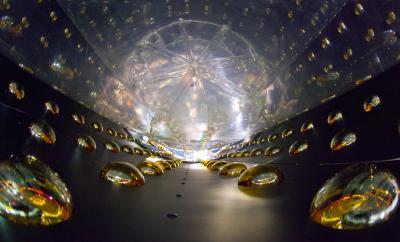Neutrinos come in three "flavors", electron, muon and tau, but they are able to 'morph' between the different types, a change called neutrino oscillation.
Neutrinos matter a lot to the future of physics because solving little mysteries can lead to solving big ones. When neutrinos were predicted in 1930 and then detected in 1956, they were also assumed to have zero mass. That belief held for 50 years but the discovery of neutrino oscillations made mass a requirement. Now physicists believe that neutrinos can be described in terms of combinations of mass states, like m1, m2 and m3 and that interference between the mass states is why we can detect oscillations of neutrino flavor; a muon neutrino could change into another flavor as it travels through the Earth - or from a muon neutrino to an electron neutrino at the T2K experiment in Japan. Solving that puzzle could also put science on a path to discovering why there is more matter than anti-matter in the universe.
In 2014, FermiLab will start firing protons for the NOvA experiment, also to study neutrinos, for a 15,000-ton detector in Minnesota. (1) 
Inside of a cylindrical antineutrino detector before being filled with clear liquid scintillator, which reveals antineutrino interactions by the very faint flashes of light they emit. Sensitive photomultiplier tubes line the detector walls, ready to amplify and record the telltale flashes. Credit: Roy Kaltschmidt, Lawrence Berkeley National Laboratory
What about after NOvA? The proposed Long-Baseline Neutrino Experiment (LBNE) would create neutrinos at Fermilab and use a new detector built in a South Dakota mine. They could detect all three flavors but also learn about neutrino mixing angles and why oscillation happens and maybe learn about violations of charge–parity symmetry - neutrinos would puncture the Standard Model if they find different oscillation rates for neutrinos and antineutrinos.
But it isn't to be. At least not right now. William Brinkman, director of the Department of Energy's Office of Science, said it is too expensive. Yet on January 8, 2010, the same Department of Energy approved a 'Mission Need' for a new neutrino experiment. Basically, the group that wasted $44 billion on solar technology boondoggles in three years, including $500 million on one company, Solyndra, that famously made the news for declaring bankruptcy after the president personally extolled them, says $1 billion to understand something fundamental about the universe is too much. 
LBNE farsite Sanford underground laboratory. Credit: FNAL
Well, maybe it is. It isn't my money and so I wouldn't waste it - that is why I am not a politician. And given the American track record in Big Science projects for the last 20 years, perhaps government is worried $1.5 billion means $5 billion and years of delays (we mean you, James Webb Space Telescope) but the odd part is they are contending there won't be $1 billion even over the next decade. Well, any scientist reading this during an election year has to be wondering why the administration can contend things are so awesome the president should be re-elected, and tens of billions of dollars are available for a pet idea like funding privately-held solar power companies, but there is no budget for actual science. Not applied science and not technology, actual fundamental science.
Obviously, other factors are working against them. Other places are doing very similar things (like T2K mentioned above) so perhaps it is not revolutionary - and it may be just politics. After the election in 2012 the administration may just go back to issuing pretend money and something of value like this can get some of it. The DoE recommendation to do something 'smaller' makes little sense, though. The Homestake mine used in planning for the lab costs $1 million a month just to pump out the water, so it's pretty much go big or go home.
More:
About LBNE
LBNE at Physics World by Hamish Johnston
LBNE at Science Insider by Adrian Cho
NOTES:
(1) The fun part of that for conspiracy theorists is that, because neutrinos react so little with Earth, they don't need a tunnel - they fire them right through the planet. How is it possible to steer them, since neutrinos have no charge and therefore magnets can't be used? They fire the protons from Fermilab’s Main Injector into a graphite cylinder and lots of fundamental particles come out, including pions, which are charged particles and therefore can be steered magnetically. They use magnets to point the pions toward the detector in Minnesota and the pions eventually decay into muons and muon neutrinos but stay on the same path.
What are the detectors made of? PVC! So respect your plumber. 
NOvA detector. Credit:FNAL
Long-Baseline Neutrino Experiment Denied By Department Of Energy



Comments